
NATCA New England 2022 Communicating for Safety Recap
It has been three years since the last Communicating for Safety conference. This year we were able to meet in person and continue what has become a premier aviation safety conference. CFS 2022 had various panels filled with valuable information controllers can utilize to move our National Airspace System forward. Some of these covered new entrants to the NAS and others covered current issues like staffing and training. Keynote speakers passed on their methods and lessons learned so our profession could benefit. The conference ended with the Archie League Medal of Safety Awards which again, did not disappoint. These awards highlight some of the aviation “saves” throughout the NAS which could involve a team of controllers or individual controllers’ efforts.
Whether you were at the convention or watching via live stream, we were all participating because of our commitment to promoting aviation safety through effective training and learning. Our job description has us as Air Traffic Controllers, but the foundation of that is our commitment to safety. That is why we can continue to all say we have the safest airspace system in the world.
Seth Myers, NATCA New England Safety Rep
I Want it All and I Want it Now: Technologies’ Realistic Road Ahead

There were a few major takeaways from this panel. The first is that the NAS is unique. At some point in time, all of the panelists referenced the fact that there is no model or system comparable to the NAS. This alone creates highly complex problems when it comes to implementing new technologies. These tend to be compounded by a lack of consistent budgeting from Congress. All of the panelists argued that as an industry a consistent source of funding is necessary for the future of the NAS, a point that NATCA is already lobbying for.
All of the panelists also gave a lot of credit to getting the controllers or individuals who would use the product involved as early as possible. This approach allows for more input on early stages of development, in turn bringing the products to the operation faster. Getting that input in early also helps guide the development team to functionality that we see as more valuable in our daily operations. Finally, all of the panelists agreed that collaboration is the standard in the industry today. There is no way to continue to improve the NAS and air travel as a whole without the input of all parties involved.
Written by Michel Farrow, ZBW
Working the Issues: A Template for Success
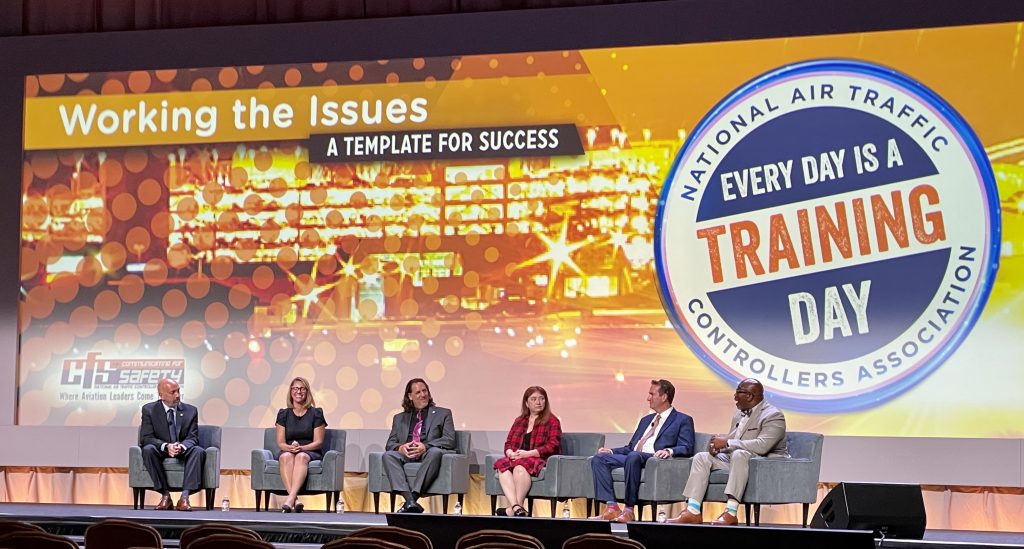
In the panel, Working the Issues: A Template for Success, the airlines, NATCA, and the FAA came together to discuss various issues affecting the NAS, including staffing and increased traffic after COVID. They explained that fixing staffing is going to be a long road, and training new air traffic controllers takes time. They’ve focused their efforts mostly on AUS and ZJX, who have had significant increases in traffic post-COVID but are also attempting to readjust total staffing numbers for facilities.
Written by Jillian Lookabaugh, BGR
Looking Ahead: Transforming the NAS to Meet New Challenges
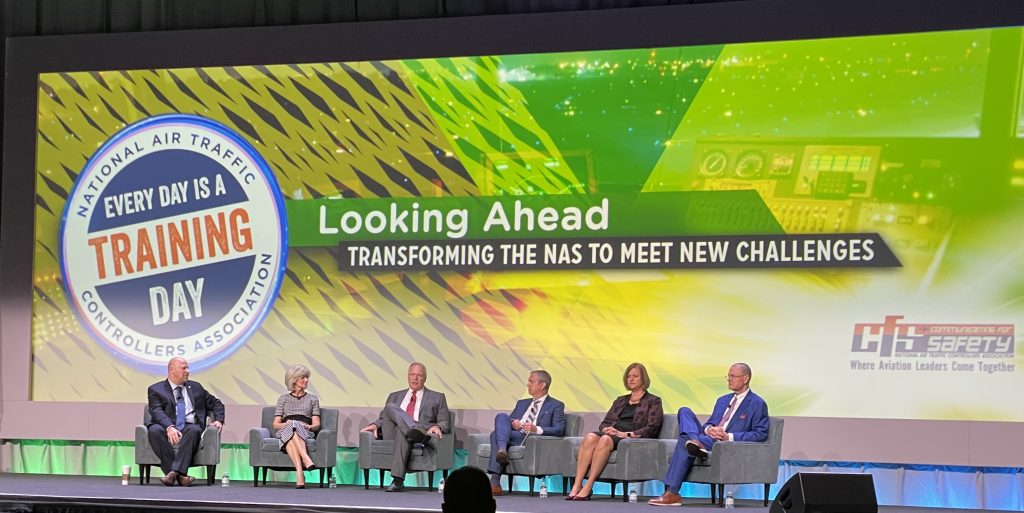
This panel featured Linda Jojo (Executive Vice President Chief Customer Officer for United Airlines), Pete Bunce (President & CEO of the General Aviation Manufacturers Association [GAMA]), Linda Daschle (former FAA Deputy Administrator and member of the FAA Management Advisory Council [MAC]), Brian Wynne (President & CEO of the Association of Unmanned Vehicle Systems International), and Todd Hauptli (President and CEO of the American Association of Airport Executives). The panel was moderated by former NATCA President Paul Rinaldi.
With new technology emerging constantly, Paul Rinaldi began by asking the panel how do we start navigating faster implementation into the NAS. Mr. Bunce stated that current procurement methods do not work. He added that private funding may allow for better integration of new technologies into the NAS. Ms. Daschle added that the FAA should work on streamlining methods of integration. The FAA is one of the first agencies to be able to “wipe the slate clean” every year as far as procurement, regardless of the political landscape. She did, however, say that the current funding of the FAA needs to become more stable and predictable for continued integration of new technologies.
Mr. Rinaldi then asked how the airlines were coping with post-COVID19 work. Ms. Jojo said that, as far as United Airlines is concerned, they are trying to meet the new demand. Although they were able to keep flying throughout the pandemic, United lost a fair number of employees. They were, however, able to implement new systems during the pandemic. One example of this is predictive weather analytics which allows United to better cope with potential weather delays and avoid unnecessary flight cancellations. Ms. Jojo also stated that as a whole, the airline industry is healthy, with new flight patterns emerging post-pandemic. One example given is the great increase in smaller markets like Austin, Texas. Mr. Hauptli commented on how airports were meeting new challenges. He described how airport operators are working to improve the airport experience. Mr. Hauptli added that smaller airports are seeing more activity than some larger hubs post-pandemic. Mr. Wynne went on to say that UAS technology is advancing rapidly. He estimates that a total of 5 million UAS will be delivered to customers for immediate use by 2030. This requires the need for swift integration into the NAS.
All the panelists went on to list other new technologies that they were a part of. Some of these include EV passenger aircraft (the first of which occurred on September 14, 2022), EVOTL (electric vertical takeoff/landing) aircraft, use of biofuels on large commercial aircraft, and increased use of solar and wind power around airports.
The one thing that all the panelists agreed on was that the FAA needs to have stable and predictable funding to be able to meet the challenges of the future.
Written by Rob Hernandez, Y90
Is it Active or Not: A Look at Special Use Airspace
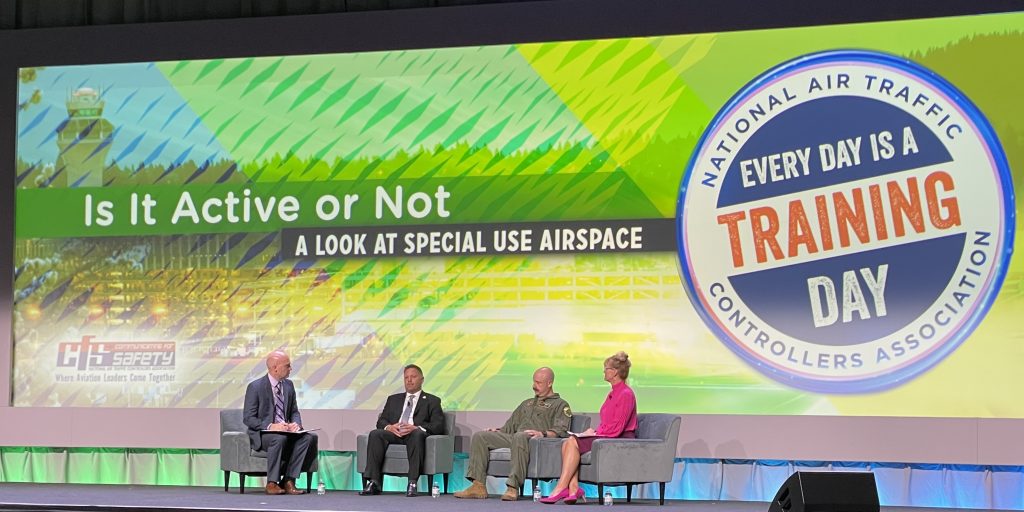
The SUA panel focused on providing a glimpse into the background of military training and missions utilizing SUA through the primary question of why SUA may be scheduled and not utilized or active without aircraft. The discussion revealed the military’s training footprint starts a year in advance, and complex training events involve multiple units, tankers, transports, and combined ground and naval forces. Mission details are often accompanied by operational security concerns, limiting the information available to ATC on missions utilizing the SUA.
The training environment is incredibly complex, with the flight lead conducting training, managing their flight, coordinating with other flights, monitoring ATC, and running the mission. The flight lead may work up to 4 radios simultaneously while also flying a high-performance aircraft. The main takeaway provided to attendees is the importance of communication with the flight in real-time and the military unit in advance. After a mission, look for synergies between the military and ATC to increase beneficial information to all.
Written by Brady Halligan, ZBW
Pilot Controller Communication: Working Together
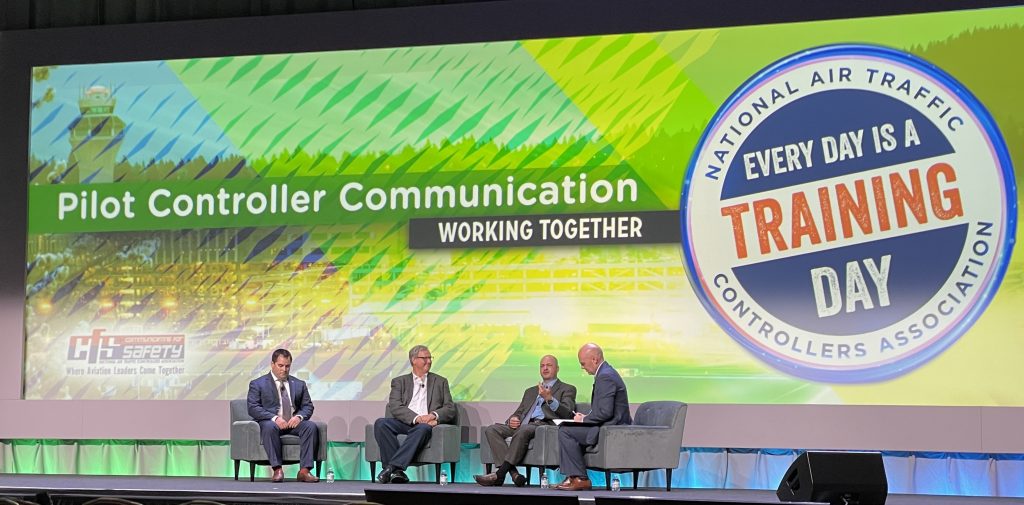
This panel was moderated by Richard Kennington and included Brad Wilcko, Pilot Controller Liaison for NATCA, John Gressett from the Cirrus Owners Pilot Association, and Jason Herman from the Airline Pilot’s Association. The focus of this panel was controller-pilot expectations from the pilot perspective and included two major topics of discussion. The first was a collaboration between the FAA and airlines to identify issues with plans and procedures and to disseminate information in a timely manner to fix any issues that may have arisen. Matters discussed included differences in aircraft performance, air carrier flight profiles, and variations in individual pilot actions and how they affect the expectations controllers have.
The second major topic of discussion was communication during emergencies and the effect on pilot workload. Task saturation was of major concern from the professional and GA representatives on the panel. A particular point was brought up that the pilot’s priority during an emergency is working through the emergency, flying the airplane, navigating, and then communicating. In an air carrier environment duties that are usually split between the flight crew are assumed by one pilot while the other works the emergency checklist.
Written by Greg Waitkus, MHT
Reporting: How I Contribute to Safety
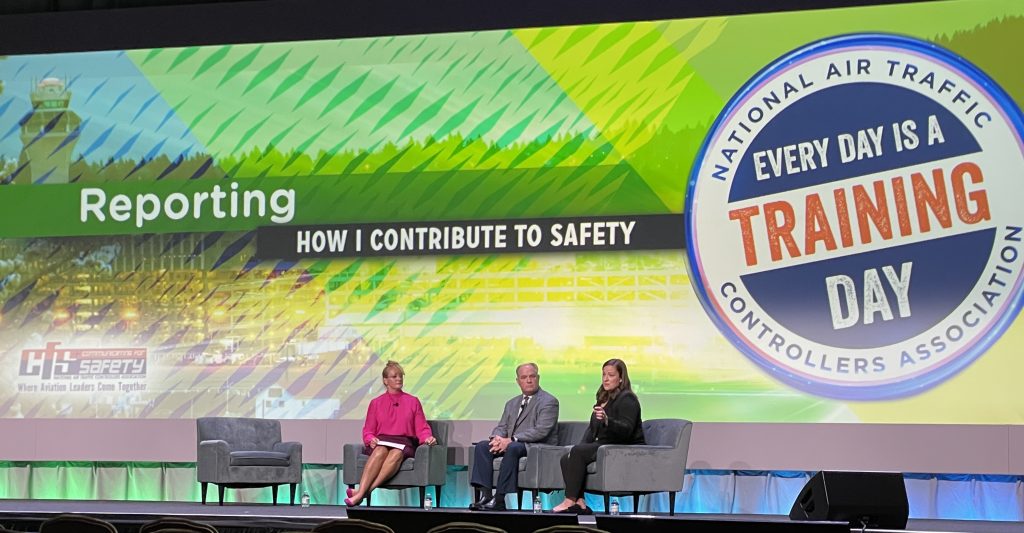
On Tuesday morning, Dawn Johnson (ATSAP Analyst Team) moderated a panel on Safety Reporting and ATSAP with panel members: Mark Woodall (B777 Captain, APA AAL) and Erin Phelps (ATSAP Analyst, NATCA).
Dawn provided an overview of ATSAP, including the history of ATSAP and the sister program with the airlines, CISP (Confidential Information Sharing Program). She highlighted some of the successes of CISP and the importance of getting all sides of the event/incident. The panelists both spoke on the importance of reporting, reminding attendees that their reports DO matter and that the data gathered is shared and used to improve the safety of the NAS. The topics in Recurrent Training are a result of ATSAP reports that are filed and the surging trends during the year.
Dawn cited that when there are issues with filing or filling out an ATSAP report, it’s usually due to users forgetting login information or forgetting to follow through with a report. Dawn encourages users to ask for help through the website, as well as to call the ATSAP hotline. Remember- ATSAP is not an FAA website, so you have access on your cell phones and while not at work. Reporting has been down during the last year, and all 3 panelists encouraged attendees to file reports often. Report, Report, Report was a message echoed by all three.
It’s our NAS- When in Doubt, Fill it out!
Written by Lisa Fulford, A90
No Train, No Gain: The Road Back
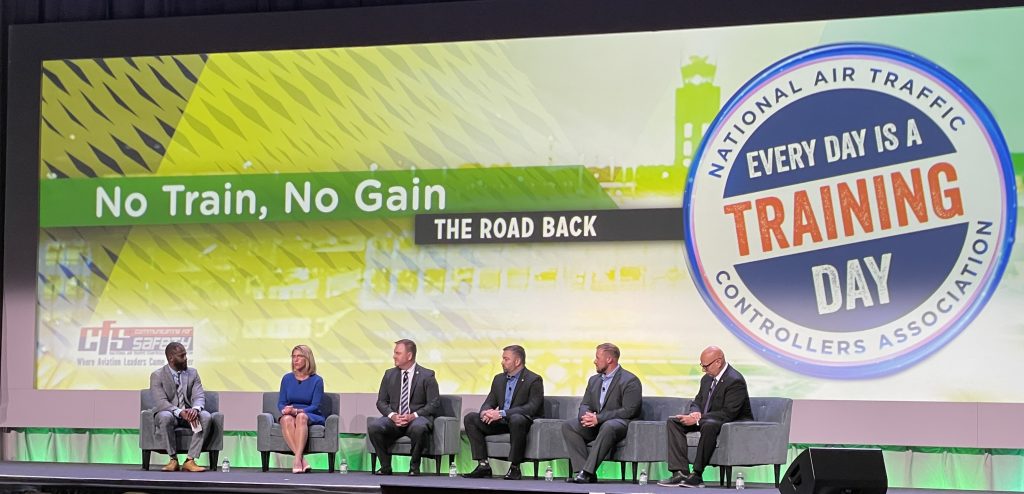
I had the distinct honor of writing a synopsis for the most beloved FAA order and joint guidance throughout the NAS, the 3120.4 (Training Order), and the NTI (National Training Initiative).
The panel consisted of two moderators: NATCA National Training Representative Jamaal Haltom and FAA Vice President of Safety and Technical Training Frank McIntosh. Along with the moderators were four panelists, including FAA Central Service Area Director of Operations Hope Kubala, NATCA Southwest Regional Vice President Nick Daniels, NATCA Dallas/Fort Worth TRACON (D10) FacRep Steve Prichard, and D10 Air Traffic Manager Nick Fannin.
During all CFS panel discussions, it was apparent that the central theme was staffing, overtime, and training. Since training Developmentals to become CPCs is the only way to combat the other two topics and training is an everyday task that all controllers are obligated to do, this panel had more substance for controllers to sink their teeth.
The panel focused on the restructuring of the 3120.4, how the NTI came to fruition and how D10 could move forward with its training program in accordance with the new guidelines. After analyzing training data from numerous facilities, inconsistent training was one of the most significant contributors to facilities having extended certifications. One facility located in Texas had each developmental averaging 1.5 hours of training a month! This facility was not low-staffed, and there was no other reason Developmentals were not receiving training other than they were not. NATCA and the FAA recognized this as a consistent trend throughout the NAS and decided to put together joint guidance to help the training process.
D10 facility representative and ATM looked into the mirror and focused on how they could fine-tune their training program. They recognized that changing their simulator lab, reducing the lag time between the sim lab to the floor, and moving onto the next sector immediately after certification instead of seasoning can significantly reduce certification times, possibly by seven months!
“How are we doing this? What are we going to accomplish? What are we doing every day to make it work? What numbers are we looking at? You have to keep driving at it. It’s a daily thing,” said Steve Prichard, D10 Facility Rep, regarding how D10 approaches the collaborative aspect of the NTI.
I have heard numerous times at my facility a question asked by a member in attendance: “Staffing shortages have created an urgency to certify Developmentals. How do we ensure safety is the top priority?” The quantity over quality argument. The answer is, “You ensure that safety is the top priority,” Jamal Haltom answered. As OJTIs, we must ensure that Developmentals are prepared and ready for certification. Per the 3120.4, the majority of the training team determines when a developmental is prepared for certification.
Key take aways from No Train No Gain:
- Your local training order was collaboratively assembled by your facility representative or their designee and the facility Training Administrator (TA).
- The only way to bolster staffing is by certifying Developmentals/CPC-Its.
- The only way to significantly decrease overtime is by certifying Developmentals/CPC-Its.
- NTI was designed to decrease the length of certification time significantly.
- NTI was designed to ensure training was conducted at all facilities, not just the core 30.
- NTI joint guidance only has expectations, NOT mandates.
- Facilities that don’t meet the expectations can log impediments.
- NTI was designed to improve the training process.
- For the NTI to be successful, members must be responsible, take ownership, and understand and support the initiative.
Written by Nicholas Cassano, PVD
Mistakes Happen: But They Don’t Have to be Repeated
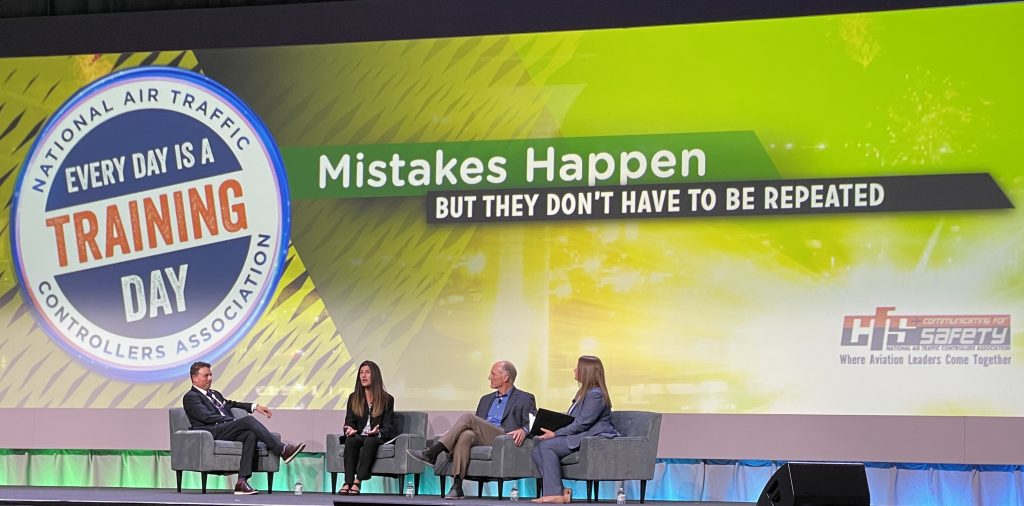
This was a very interesting panel involving a corporate pilot, Sheri “Sharki” Kontra, and a former USAF Thunderbirds commander Richard McSpadden. Sharki recounted a pilot deviation she was involved in, where she was preparing for a certification flight. With a flight instructor on board, they landed on the wrong runway in front of a B737 that they had reported in sight. Due to mental lapses/overly focused on a difficult maneuver, both pilots made a wrong surface landing resulting in a go-around by the B737. Richard McSpadden added how when flying with the Thunderbirds if a pilot had 3 minor mental slips, i.e forgetting to run checklist items or getting distracted during a flight they would terminate the flight or practice.
Aaron Katz, the National Human Performance Representative for Natca, stated many times in Air traffic we are tasked to work a busy session or sector when we are not feeling on our A game. It is very important to conduct a self-assessment prior to work and be honest with yourself to see if you are mentally and physically prepared to work. Even when we feel our best we can still have errors due to small mental slips. We become callused to the daily risks involved in ATC and are constantly pushing the envelope. Be aware of the risks involved, your mental and physical state, and whatever stresses you have in your life, both at and outside of work.
Written by Nick Flickner, BOS
Aviation’s New Frontier: Has the Jetson’s Age Arrived?
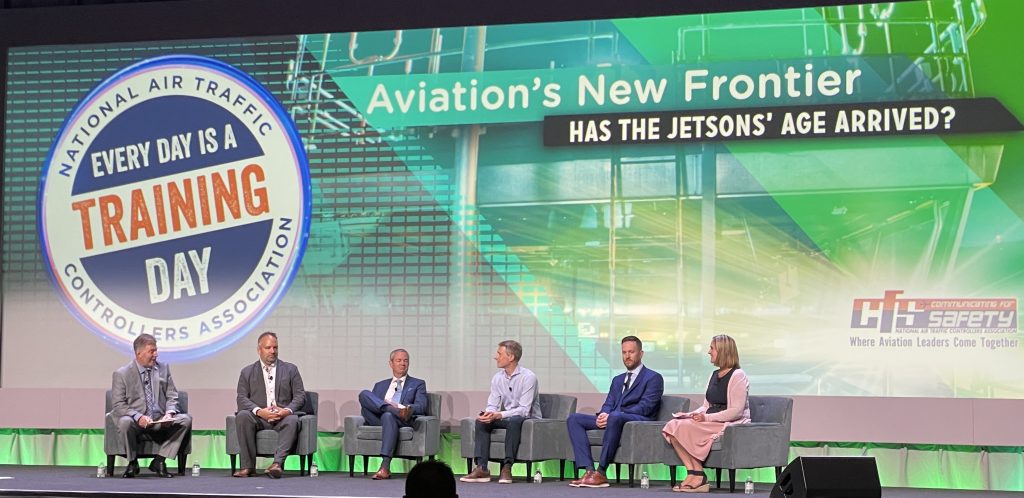
This panel discussed and highlighted some of the newest technology and innovation in the aviation industry. As a whole, these new technologies are referred to as Advanced Air Mobility (AAM) and are intended to move people and cargo between places previously underserved by aviation. Under the larger umbrella of AAM are more niche categories such as Regional Air Mobility (RAM), Urban Air Mobility (UAM), Unmanned Aircraft Systems (UAS), and eVertical Takeoff and Landing (eVTOL).
These systems have the potential for a number of different services such as: linking smaller rural areas to large airports (increasing accessibility and affordability of travel), safe and efficient transportation of passengers or cargo at lower altitudes in densely populated areas, more efficient public services (medical, fire, search and rescue, etc), and many other applications. Some companies are already using the technology for eVTOL and autonomous air cargo.
It seems as though the Jetson’s Age has arrived. The technology is here, as well as a number of ways to use and benefit from it. The next question will be how it is integrated into the NAS. What will the infrastructure look like? What will the impact be on ATC (airspace, regulations, controllers)? Will the public acceptance of new technology ultimately determine how far this technology can go?
Written by Trevor Wheelock, ACK
Synthesizing the NAS: Aviation’s New Frontier and Our Existing System
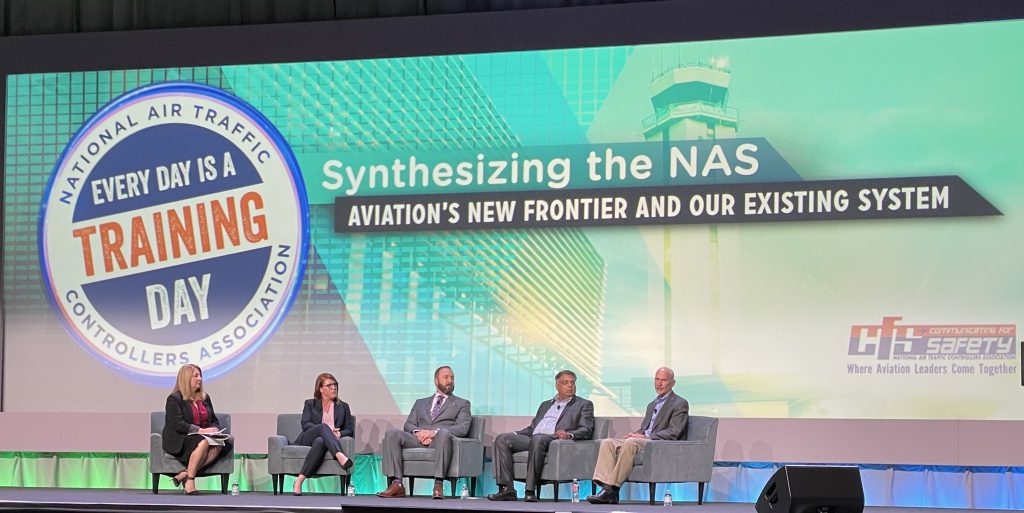
The primary objective of this panel was to discuss the integration of UAS/AAM/UAM and other systems into the NAS. Topics included current and future issues/constraints as well as technologies being developed to further integrate these systems into the NAS. One of the primary concerns is the patchwork of systems various ANSPs have developed that do not integrate well together. Technologies developed by these companies generally focus on just that company’s product and the specific area of operation. This has created a very piecemeal approach that is further complicating integration.
The current suite of deployed technologies is likely not to replace the controller any time soon. While LAANC and UTM are a good start, most of the panelists did not believe UAS corridors to be the solution, This technology is not scalable and will not be the hallmark of UAS integration. In terms of priority, most panelists agreed that AAM should be first to integrate, followed by UAS. We need to focus on the big things first and the FAA and its employees should be the stewards of this change. If the USA develops and integrates an appropriate system, then the world will follow.
Written by Andrew Breen, BDL
NATCA’s NextUp Training Workshop
NATCA’s NextUp program was developed a few years ago trying to work with the next generation of NATCA leaders by working with them very early in their NATCA careers. Earlier on, NATCA focused on getting more women involved at the local level by targeting them with this program. We have seen great results from this program as the diversity in local NATCA leadership has grown. This program has generally been associated with CFS and the classes and meetings and social events were the Sunday before CFS began.
Mick Devine, NNE RVP
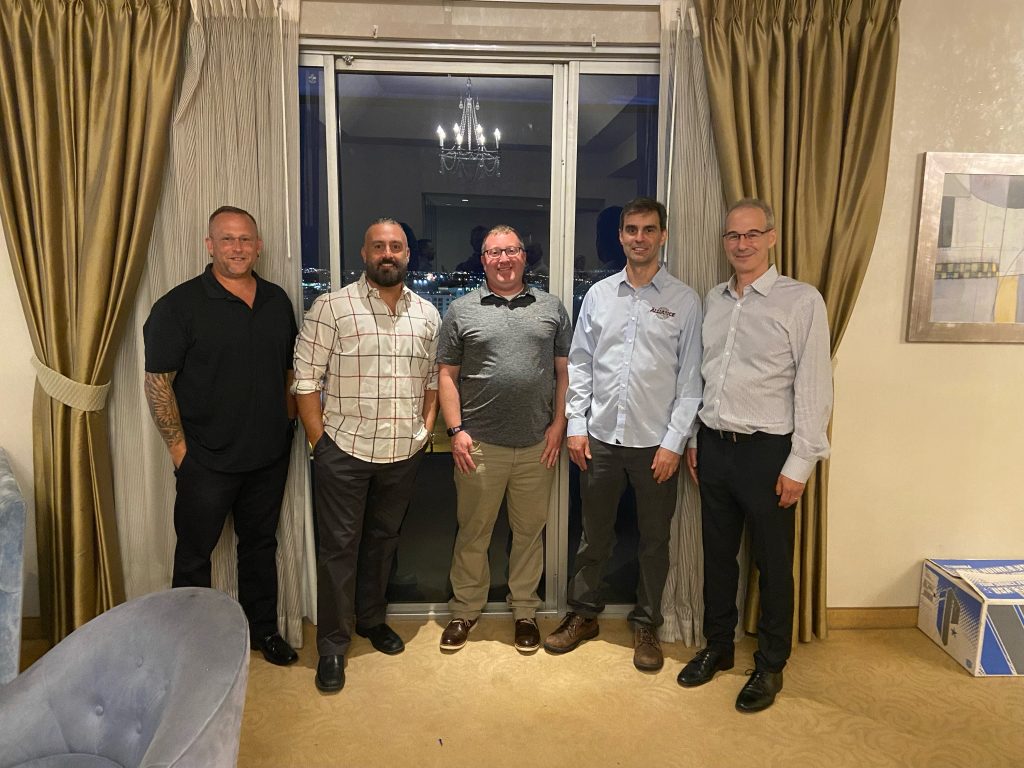
Hello NNE. I was fortunate to attend The Next Up training NATCA held just before our CFS Event. This was an opportunity to hear from some of our National Leadership speak on never staying comfortable in your role. I took two things away from the training, that may be obvious, but it’s important to be refreshed on both to avoid becoming complacent in your role as a NATCA Representative. The first is to routinely challenge how things can be better. Even as little as setting goals to change things to be 1% better, will improve things by large margins over time. The second, that I know we can all fall into a trap is to avoid bias in the workplace. It takes an effort to be aware and to avoid. Just like setting small goals to improve greatly over time, a conscious decision to not fall into the traps of preconceived notions will eventually become a habit. I’m appreciative that I was selected to attend Next Up and in the event regional leadership reaches out, I’d urge anyone to attend.
Written by Kevin Curtiss, ZBW
While attending Next Up prior to CFS, I attended a class called “You Don’t Need a Title to be a Leader”. The presenters encouraged us to think about what it means to be a good leader and to identify the qualities of good leaders. I began to reflect and identify some qualities of good leaders. Good leaders are open and honest when communicating. They are committed to their ‘team”, by building trust and connecting with them. A good leader is a positive influence who sets an example. This is where we can all have an enormous impact, by having a more positive attitude, and not focusing on the negative. By setting an example and looking for the positive in order to improve the workplace climate, we can all be leaders.
We truly don’t need a title to have an impact on those around us. Whether we like it or not, people will pick up on our habits, good or bad. Instead of continuously being negative, consciously try to focus on how your negative comment will impact someone else and/or the operation. At the very least keep it to yourself, because it can be a distraction, as well as bringing others down in the process. If you get the opportunity, I strongly suggest attending an in-person class or even one of the many virtual trainings offered by NATCA. Thank you!
Written by Nicholas Monahan, BED

